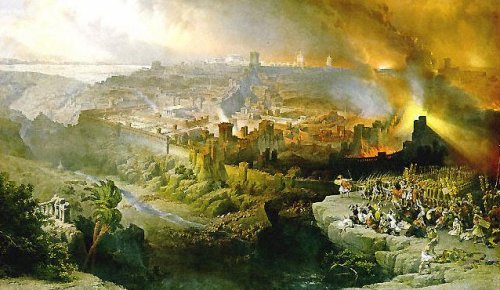

This is not an Anti-Semitic rant.
When I refer to Jerusalem, I am referring to a system that has political/economic/spiritual ramifications that Jesus Himself had to deal with when He was upon the earth. I ask the reader to follow the next few posts on this subject and, using the Scriptures, make an informed judgment as to the validity of the argument.
The case for identifying Jerusalem as the intended reference for the harlot image in Revelation proceeds on several fronts. Some are related to internal evidence throughout the Apocalypse; others involve the background of the rest of Scripture and general thematic emphases of biblical prophecy. But when taken together, I am persuaded that these lines of argument point in one primary direction, as we will see in the following evaluation of the evidence.
Babylon Imagery in Jewish Sources One of the chief reasons many have contended that Babylon represents Rome in the Apocalypse is the widely recognized fact that a number of Jewish sources use this device to critique Rome. Certainly this is not uncommon, and it is understandable that many commentators find this compelling. Moreover, this argument presupposes the understanding that these Jewish writers used such imagery in light of the destruction of the temple, an act first executed by historical Babylon, and later recapitulated by the Romans.
A second difficulty with the Jerusalem view for some is the lofty language used by the author of Revelation to describe the city of Babylon, especially in 17:18 which reveals the identity of the harlot as “the great city which has dominion over the kings of the earth” From a sheer political standpoint, this seems very persuasive.
The City on Seven Hills Jerusalem was known long before Rome as the city of Seven Mountains/hillsRev 17:9: And here is the mind which hath wisdom. The seven heads are seven mountains, on which the woman sitteth.1. Mt. Gareb, 2. Mt. Acra, 3. Mt. Goath 4. Mt. Bezetha, 5. Mt. Zion, 6. Mt. Ophel, 7. Mt. Moriah.Revelation more naturally evokes the image of Jerusalem as the city seated on seven mountains in 17:9 than Rome.
The view that Babylon is a cipher for Jerusalem in the Apocalypse cannot then be dismissed on the basis of this common objection; not only can it be defended that the evidence of 17:9 can fit Jerusalem, there are strong reasons to believe that it in fact does most properly fit Jerusalem.
Taken from:
No comments:
Post a Comment